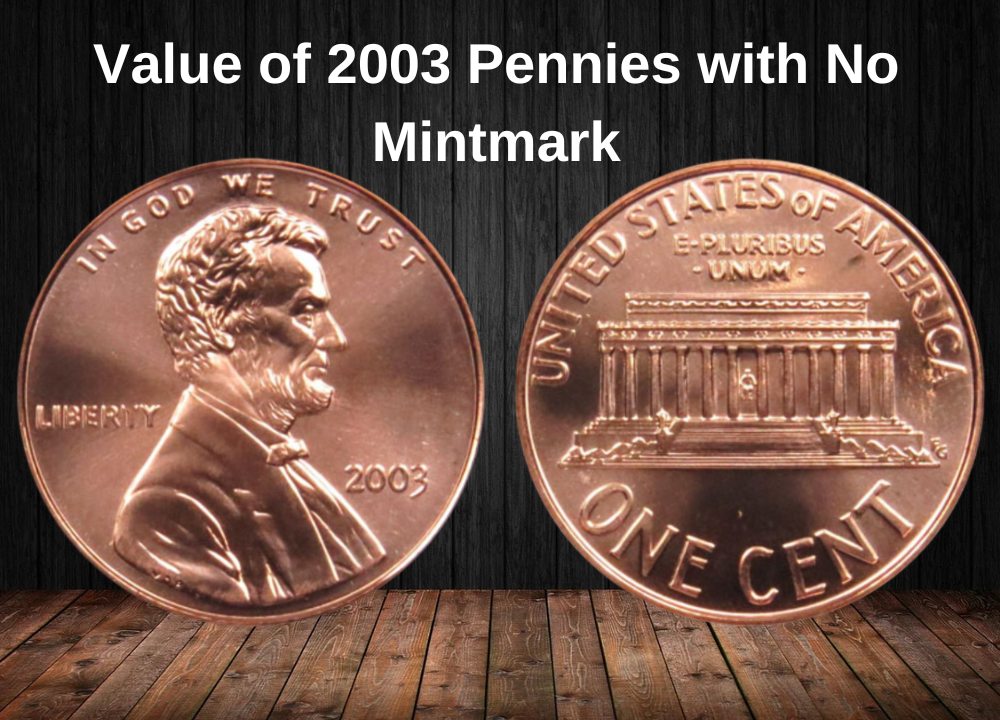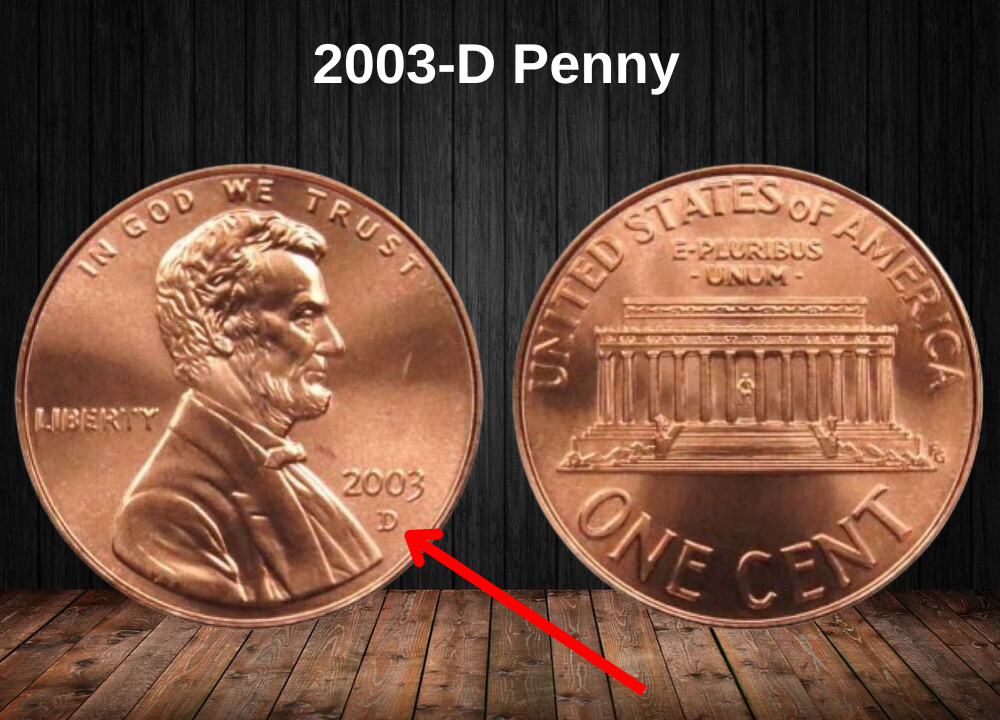
While the vast majority of 2003 pennies are only worth their face value of one cent, there are some rare exceptions that can fetch hundreds of dollars!
It might sound unbelievable, but it’s definitely true.
So, how can you spot which 2003 pennies are valuable keepsakes and which ones you can just spend without worry?
Keep reading to discover the specific traits that make certain 2003 pennies stand out…
Value of 2003 Pennies with No Mintmark

In 2003, the Philadelphia Mint produced an enormous number of Lincoln pennies — about 3.3 billion! So, it’s no surprise that these pennies are still common in circulation today.
If you have a 2003 penny without a mintmark (no letter below the date), that means it was minted in Philadelphia — which was standard for most coins from this location.
What’s the value of these no-mintmark 2003 pennies?
Because so many were made and because copper prices haven’t driven up their worth, worn and circulated examples are generally worth just their face value — one cent. So feel free to use those in your change without hesitation.
That said, uncirculated 2003 pennies—coins that look brand new and have never been spent—do have some collectible value. Depending on their condition, they typically sell for around 10 to 30 cents each. Coins in pristine condition, graded by professional services, can command even higher prices.
For instance, the highest recorded sale for a 2003 no-mintmark penny was nearly $175 in 2021. This was for a coin graded MS69RD by the Professional Coin Grading Service, meaning it was almost perfect with a deep red color.
2003-D Penny Value (“D” Mintmark)

The 2003-D Lincoln cent was minted at the Denver Mint and is identified by a small “D” mintmark located just below the date on the coin.
In 2003, the Denver Mint produced approximately 3,548,000,000 of these pennies. Like their Philadelphia counterparts, these coins are extremely common, and you’ll likely find many 2003-D pennies in circulation or in collections.
Here’s how much a 2003-D penny is worth:
Since these pennies contain only a small amount of copper, circulated coins with wear are worth just their face value of 1 cent. So, if you find a worn 2003-D penny in your pocket change, it’s safe to spend.
However, uncirculated specimens—coins showing no signs of wear—are typically worth 10 to 30 cents.
The most valuable known 2003-D penny was graded MS69RD by the Professional Coin Grading Service and sold for $595 in 2019.
2003-S Penny Value (“S” Mintmark)
The 2003-S penny is a special proof coin that was intended only for coin collectors.
It was minted at the San Francisco Mint and therefore features an “S” mintmark below the date. A total of 3,298,439 were produced.
2003-S proof pennies are known for their shiny, mirror-like surfaces, which result from their unique manufacturing process:
- These coins are made from highly polished blanks.
- They are struck twice using specially prepared dies on high-tonnage presses to bring out incredibly sharp detail.
Unlike regular coins, proof coins are not released into circulation. They are sold directly by the U.S. Mint in special collector sets.
However, sometimes these coins are broken out of their original packaging and accidentally spent. These are known as “impaired proofs”, and they occasionally turn up in circulation.
IMPORTANT: What Is The Grade Of Your 2003 Penny?
A List Of Rare 2003 Error Pennies To Look For
2003 Doubled Die Penny Error
The 2003 doubled die penny is a rare and interesting variety that many collectors actively search for. However, as with most rare errors, this isn’t a coin you’re likely to stumble upon after just a few days of digging through pocket change or bank rolls. In fact, some collectors spend years searching before ever finding a genuine doubled die.
That said, not every doubled die is worth a fortune. While some dramatic examples can fetch hundreds or even thousands of dollars, most 2003 doubled die pennies are more subtle and less dramatic.
These minor doubled die varieties usually sell for around $25 to $50, though prices can be higher depending on demand and the visibility of the doubling.
Where To Look for Doubling on a 2003 Penny:
- Obverse (heads side):
- Lincoln’s eye
- Ear
- Date
- Lettering (such as “IN GOD WE TRUST” or “LIBERTY”)
- Reverse (tails side):
- Lettering (like “UNITED STATES OF AMERICA” or “ONE CENT”)
- Lincoln Memorial columns
- The tiny statue of Abraham Lincoln inside the Memorial
Keep a magnifying glass handy when searching — minor doubled dies can be tough to spot with the naked eye!
2003 Off-Center Penny Error
A 2003 off-center penny is one of the most visually striking types of error coins you can find. These coins were misstruck when either the coin blank (planchet) wasn’t properly aligned or the dies themselves were out of position during minting.
However, not all off-center pennies from 2003 are worth a lot of money.
- Minor off-center errors — coins that are off by only 10% to 20% — are fairly common and usually sell for around $5 to $10.
- To be truly valuable, the off-center error needs to be dramatic and still show important details.
What Makes a 2003 Off-Center Penny Valuable?
- The most valuable examples are off by 50% to 60%.
- They must still show the full date and mintmark (if any).
- These rare examples can be worth $75 to $150 or more, depending on their condition and visual appeal.
Always examine both sides of the coin carefully — missing parts of the design or date can significantly lower the coin’s value, even with a dramatic misstrike.
2003 BIE Penny Error
The BIE variety is a fascinating and unique error found only on Lincoln cents — and yes, it includes some 2003 pennies!
This error appears on the obverse (front) of the coin, near Lincoln’s portrait, and involves a small die break in the word “LIBERTY.”
What To Look For:
- Specifically, the coin shows what looks like a capital letter “I” between the “B” and “E” in LIBERTY.
- This happens due to an aging or damaged die — which develops a small vertical crack, often forming that blobby “I” shape.
- These are called die breaks, and they create raised lines or lumps on the coin’s surface.
How Much Is A 2003 BIE Penny Worth?
- A genuine 2003 BIE penny can fetch between $7 and $15, depending on the size and clarity of the break.
- Sharper, more prominent breaks that closely resemble the letter “I” tend to bring higher prices.
These little oddities are especially popular among Lincoln cent variety collectors, so be sure to check every 2003 penny you find!
2003 Broadstrike Penny Error
If you come across a 2003 penny that looks wider than normal and seems to be missing its raised rim, you may have a broadstrike error in your hands!
What Is a Broadstrike Error?
- This type of error happens when a coin is struck outside of the retaining collar — the part of the minting press that shapes the coin’s rim and keeps its diameter correct.
- Without the collar in place, the metal spreads out more than usual, causing the coin to appear broader and sometimes thinner than a typical penny.
- Despite the unusual shape, a broadstruck coin will still show the entire design, though it may look slightly distorted.
How Much Is It Worth?
- A genuine 2003 broadstrike penny is worth around $10 to $25, depending on its condition and the extent of the strike.
FAQ about the 2003 Penny
1. What is the composition of the 2003 penny?
The 2003 Lincoln penny is made of 97.5% zinc and 2.5% copper, with a copper-plated zinc core — a standard composition used since mid-1982.
2. Which mints produced the 2003 penny?
Three U.S. Mint facilities produced the 2003 penny:
- Philadelphia Mint (no mint mark)
- Denver Mint (“D” mint mark)
- San Francisco Mint (“S” mint mark) for proof coins only
3. Are there any notable errors or varieties for the 2003 penny?
Yes. While there are no major listed doubled die varieties, collectors have found errors such as:
- Off-center strikes
- Die cracks or cuds
- Clipped planchets
- Broadstrikes
Some of these errors are relatively minor, but certain examples can command higher prices depending on rarity and condition.
4. What designs appear on the 2003 Lincoln penny?
- Obverse: A right-facing portrait of President Abraham Lincoln, designed by Victor D. Brenner
- Reverse: The Lincoln Memorial, which was used on the reverse of the penny from 1959 to 2008
5. How many 2003 pennies were minted?
The 2003 penny had high mintage numbers, making it a common modern coin:
- Philadelphia Mint: Over 3.3 billion
- Denver Mint: Over 3.5 billion
- San Francisco Mint (Proofs): About 3 million
6. What is the value of a 2003 penny?
- Circulated coins: Face value (1¢)
- Uncirculated coins: $0.10 to $1+ depending on condition
- Proof coins (2003-S): $1 to $3+
- Error coins: Varies by type; some can be worth $10 to $100+
7. Is the 2003 penny a good coin to collect or invest in?
While circulated 2003 pennies are very common and not considered strong investments, high-grade MS66+ coins, proofs, or mint errors can have collectible value and may appreciate over time.


















































